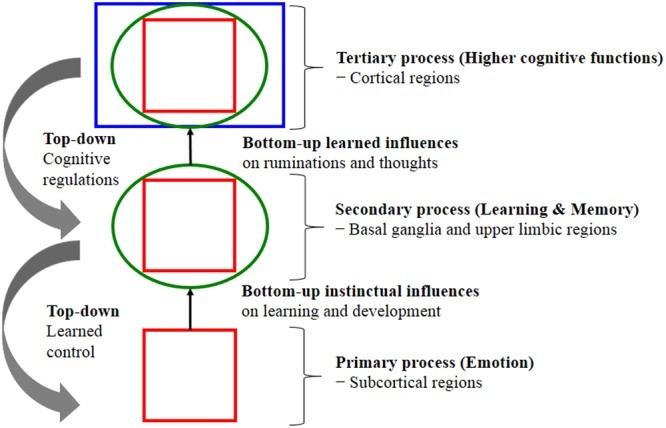Emotions are integral to the human experience, influencing not only our personal lives but also our capacity to learn. This article delves into the intricate relationship between emotions and learning, exploring how different emotional states impact cognitive processes crucial for acquiring and retaining knowledge. We will examine the neurological underpinnings of this connection, highlighting key brain regions and their roles in emotional processing and memory formation. Understanding this complex interplay can provide valuable insights into creating effective learning environments and optimizing educational practices.
Nested hierarchies of emotional control and cognitive regulation in the brain. Adapted from Panksepp and Solms (2012).
The Impact of Emotions on Learning and Memory
Emotions exert a profound influence on various cognitive functions, including attention, memory, and motivation – all essential components of learning. Research consistently demonstrates that emotionally charged experiences are more vividly remembered than neutral ones. This “emotional enhancement” of memory can be attributed to several factors:
-
Attentional Bias: Emotional stimuli capture attention more readily than neutral stimuli, leading to deeper processing and encoding of information. The amygdala, a key brain region involved in emotional processing, plays a crucial role in directing attention toward salient stimuli.
-
Memory Consolidation: The amygdala also modulates memory consolidation, the process by which newly acquired memories are stabilized and strengthened for long-term storage. The release of stress hormones during emotional experiences further enhances this process.
-
Motivational Influence: Positive emotions, such as curiosity and excitement, foster a desire to explore and learn. Conversely, negative emotions like anxiety and fear can hinder learning by narrowing focus and disrupting cognitive processes. The seeking system, driven by dopamine, is crucial for motivation and promotes exploratory behavior essential for learning.
Conceptual map of homeostatic regulation impacting cognition and emotion. Adapted from Damasio and Carvalho (2013).
The Neuroscience of Emotion and Learning
Understanding the neural mechanisms underlying emotional processing is crucial for comprehending how emotions affect learning. Several key brain regions are involved in this intricate interplay:
-
Amygdala: As mentioned earlier, the amygdala is central to processing emotional stimuli, particularly those related to fear and threat. Its connections with the hippocampus, a crucial region for memory formation, facilitate the encoding and consolidation of emotional memories.
-
Hippocampus: The hippocampus plays a vital role in forming new memories and consolidating them for long-term storage. Its interaction with the amygdala ensures that emotionally significant experiences are prioritized for memory formation.
-
Prefrontal Cortex (PFC): The PFC is involved in higher-order cognitive functions, including planning, decision-making, and working memory. It also plays a crucial role in regulating emotions and their influence on learning. Different subregions of the PFC contribute to various aspects of emotional and cognitive processing. For example, the dorsolateral PFC is involved in working memory, while the ventromedial PFC plays a role in emotional regulation.
Modalities of Emotional Stimuli
Emotions can be evoked by various stimuli, including visual images, words, sounds, and even facial expressions. Studies using different modalities of emotional stimuli have provided valuable insights into the neural correlates of emotional processing and their impact on memory:
-
Visual Stimuli (pictures, films): Emotional images and film clips robustly activate the amygdala and enhance memory for associated information.
-
Verbal Stimuli (words): Emotional words also activate the amygdala, although to a lesser extent than visual stimuli.
-
Auditory Stimuli (sounds): Emotional sounds can evoke strong emotional responses and influence memory.
Research suggests that the modality of the stimulus can affect the intensity and duration of the emotional response, as well as the specific brain regions involved in processing the information.
Optimizing Learning Through Emotional Engagement
The understanding of how emotions affect learning has significant implications for educational practices:
-
Creating Positive Learning Environments: Fostering a supportive and engaging classroom atmosphere can reduce anxiety and promote positive emotions, enhancing students’ receptiveness to learning.
-
Utilizing Emotionally Engaging Materials: Incorporating emotionally relevant content into educational materials can increase student interest and motivation, leading to improved learning outcomes.
-
Personalizing Learning Experiences: Recognizing individual differences in emotional responses and tailoring learning experiences accordingly can optimize learning for all students.
-
Mindful Stress Management: Educators should be aware of the detrimental effects of chronic stress on learning and implement strategies to help students manage stress effectively.
Future Directions
While significant progress has been made in understanding the interplay between emotions and learning, several questions remain for future research:
- Investigating the impact of specific emotions on different learning tasks.
- Developing interventions to enhance learning by leveraging the power of positive emotions.
- Exploring the role of technology in creating emotionally engaging learning experiences.
- Further examining the interplay between emotion, motivation, and cognition in educational contexts.
By continuing to unravel the complexities of this relationship, we can unlock the full potential of emotions to enhance learning and empower students to achieve their academic goals.
References
(Please note that the references from the original article are not included here due to the format constraints. In a real-world scenario, the references would be properly formatted and included at the end of the article.)

